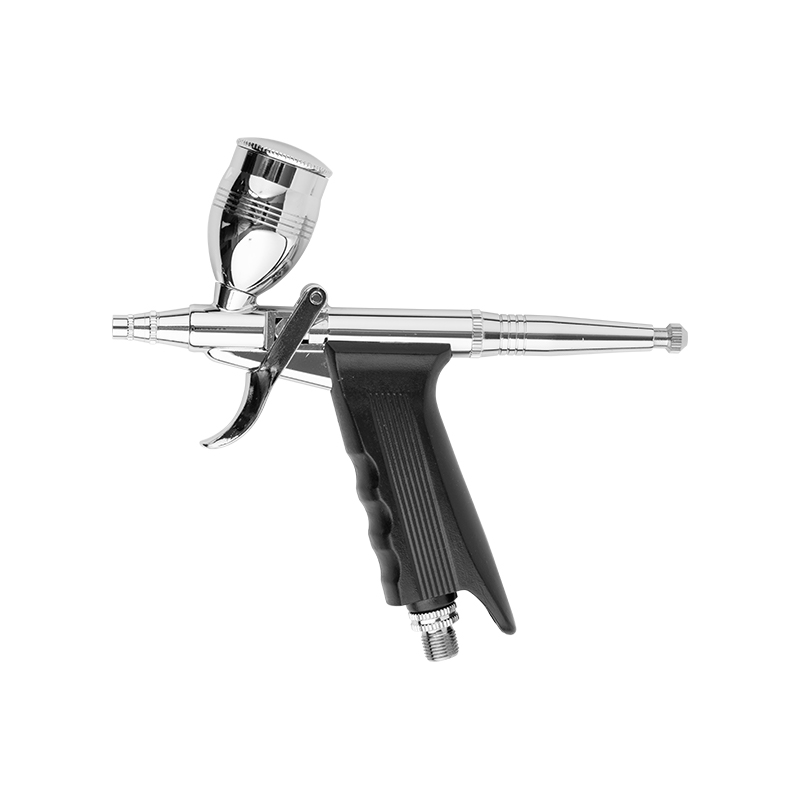TM126 Fristående bärbar airbrush
Cat:Airbrush
En fristående bärbar airbrush hänvisar vanligtvis till ett airbrush-system som inkluderar alla nödvändiga komponenter f...
Se Detaljer Förberedelse innan du använder luftborsten
Innan du använder luftborste , adekvat förberedelse är nyckeln till att säkerställa säkerhet. Först måste du noggrant läsa Airbrush's Instruktionshandbok för att förstå de grundläggande driftsmetoderna och säkerhetsåtgärderna för utrustningen. För det andra, kontrollera om luftborsten och dess tillbehör är intakta för att säkerställa att det inte finns någon sprickor, löshet eller andra avvikelser. Arbetsmiljön bör vara väl ventilerad för att undvika ackumulering av färg eller lösningsmedelsgaser i luften och orsaka brand eller förgiftningsrisker. Förbered samtidigt lämplig personlig skyddsutrustning, inklusive skyddsglasögon, masker, skyddshandskar och skyddskläder för att minska risken för inandning av skadliga gaser och hudkontakt. Bekräfta att luftkälltrycket uppfyller de tekniska kraven för luftborstningen för att undvika skador eller olyckor som orsakas av överdrivet tryck.
Säkerhetsåtgärder under drift
Under sprutoperationen bör operatören alltid vara vaken och strikt följa de föreskrivna driftsstegen. När du använder en airbrush, se till att munstycket riktar sig till målytan för att undvika avvikelse från sprayriktningen, vilket får lösningsmedel eller färg att stänkas på operatören eller omgivande personal. Vid sprutning med en airbrush bör operatören hålla ett lämpligt avstånd från sprutytan för att förhindra färgstopp eller gasåterhämtning på grund av för nära avstånd. Undvik långsiktig kontinuerlig sprutning för att minska risken för trötthet och felaktigt. När du använder luftborsten, pek inte munstycket på människokroppen eller djuren. Undvik att använda luftborsten i brandfarliga och explosiva miljöer för att förhindra brand- och explosionolyckor. Under arbetet, undvik att äta och röka för att förhindra säkerhetsolyckor orsakade av brandkällor.

Säkerhetsåtgärder för underhåll och rengöring av luftborste
Efter att ha använt Airbrush är snabb och standardiserad underhåll och rengöring viktiga steg för att säkerställa utrustningens prestanda och säkerhet. Vid rengöring av airbrushen bör gaskällan kopplas bort för att förhindra oavsiktlig start. Använd ett lämpligt rengöringsmedel för att rengöra munstycket och måla kammaren och undvik att använda brandfarliga eller giftiga lösningsmedel. Rengöring bör utföras i en väl ventilerad miljö för att förhindra skadlig gasansamling. Rena föroreningar och rester inuti luftborstningen för att undvika försämring av spraykvalitet eller utrustningssvikt. När du demonterar luftborstdelar, var uppmärksam på driftsmetoden för att undvika skador på utrustningen. Under underhåll, slit skyddsutrustning för att förhindra att kemikalier stänker på huden eller ögonen. Kontrollera regelbundet tätningarna och lederna på luftborsten och byt ut dem i tid om de åldras eller skadas för att undvika gasläckage.
Nödbehandling och säkerhetsåtgärder
Under användningen av airbrush kan olika nödsituationer uppstå, såsom utrustningsläckage, brand, gasförgiftning etc. Operatören bör vara bekant med nödbehandlingsprocessen och stänga av gaskällan och strömförsörjningen i tid för att förhindra att olyckan expanderar. Om spraymaterialet läcker, bör det snabbt styras med absorberande material, och platsen ska rengöras för att förhindra halkar eller bränder. I händelse av en brand bör en brandsläckare användas omedelbart för att släcka den, och vatten bör undvikas för att släcka oljiga eldar. Arbetsplatsen ska vara utrustad med nödvändig brandbekämpningsutrustning och första hjälpen läkemedel för att säkerställa att den kan hanteras under första gången. Operatören bör få relevant säkerhetsutbildning och behärska grundläggande första hjälpen kunskap och brandbekämpning. Utför säkerhetsövningar regelbundet för att förbättra förmågan att svara på nödsituationer.
Miljöskydd och hälsoskydd
Sprayen och skadliga gaser som genererats under användningen av luftborsten har en viss inverkan på miljön och människors hälsa. Driftsmiljön bör vara utrustad med ett avgassystem för att upprätthålla luftcirkulationen och minska koncentrationen av skadliga gaser. Avfallsfärg och lösningsmedel bör hanteras i enlighet med miljöskyddskraven för att undvika förorenande vattenkällor och jord. Operatörer bör bära dammmasker eller andningsskydd för att förhindra inandning av skadliga partiklar och flyktiga organiska föreningar. Undvik långvarig exponering för sprutmiljön för att minska hälsoriskerna. Stärka utrustningsunderhållet för att undvika miljöföroreningar orsakade av läckage. Företag bör formulera säkra driftsförfaranden och genomföra miljöskyddsåtgärder för att säkerställa säkerheten för operatörer och den omgivande miljön.
Airbrush Safety Assuards
| Punkt | Beskrivning |
|---|---|
| Förberedelse i förväg | Läs manualen, inspektera utrustning, förbereda personlig skyddsutrustning, säkerställa god ventilation |
| Driftsäkerhet | Följ procedurer strikt, kontrollera sprayriktning och avstånd, undvika sprutning på människor, använd inte i brandfarliga eller explosiva miljöer |
| Underhåll och rengöring | Koppla bort lufttillförseln, använd lämpliga rengöringsmedel, bära skyddsutrustning, kontrollera regelbundet och byt ut tätningar |
| Nödhantering | Var bekant med nödprocedurer, utrusta brandbekämpning och första hjälpen enheter, genomföra regelbunden säkerhetsutbildning och övningar |
| Miljö- och hälsoskydd | Håll ventilation, kassera avfall ordentligt, bära skyddsmasker, begränsa exponeringstiden, implementera miljöåtgärder |
Kontakta oss